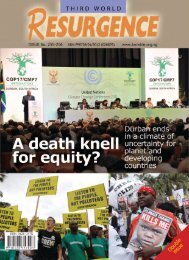Plantations, poverty and power - Critical Information Collective
Plantations, poverty and power - Critical Information Collective
Plantations, poverty and power - Critical Information Collective
Create successful ePaper yourself
Turn your PDF publications into a flip-book with our unique Google optimized e-Paper software.
114<br />
In the mid-1970s, FAO intensified its support of the expansion of the industrial tree plantations <strong>and</strong> the<br />
pulp <strong>and</strong> paper industry in the global South. The theme of a 1975 issue of FAO’s forestry magazine<br />
Unasylva was “It’s time to make paper in the tropics.” In the magazine, FAO’s Ken King argues that<br />
“plantations <strong>and</strong> mixed tropical hardwoods are the pulp sources of the future, <strong>and</strong> the future is at<br />
h<strong>and</strong>”.588 FAO’s role in the exploitation of these “pulp sources” is equally explicit:<br />
“It is evident that the governments of most of these [tropical] countries would require financial <strong>and</strong><br />
technical/managerial assistance if their plans are to be implemented. FAO is prepared to assist in the<br />
bringing together of governments <strong>and</strong> potential investors, in the hope that these plants would be<br />
established.”589<br />
Two years later Ken King, then-head of forestry at the FAO, reported that, a large number of Southern<br />
governments had approached the FAO to study the feasibility of establishing “some type of pulp <strong>and</strong><br />
paper factory, of one kind or another”.590<br />
By the mid-1980s, about four million hectares of eucalyptus plantations had been planted, in more than<br />
80 countries.591 During the 1980s, rural communities started to protest against industrial tree plantations<br />
in the South, particularly in India <strong>and</strong> Thail<strong>and</strong>. In 1986, in response to the protests, FAO produced a<br />
study, funded by Sweden’s aid agency, SIDA, titled “The ecological effects of eucalyptus”. The<br />
arguments in favour of industrial tree plantations were the same as in the 1960s (<strong>and</strong> the same as that<br />
from plantation proponents today): “There are high <strong>and</strong> increasing dem<strong>and</strong>s for wood for industrial use<br />
<strong>and</strong> fuel needs, especially in developing countries of the tropics with their growing populations.”592<br />
The authors of the report, D. Poore <strong>and</strong> C. Fries, noted that<br />
“A growing body of opinion claims that eucalypts cause a variety of short-to long-term ills,<br />
impoverishing the environment in terms of the soils, water availability <strong>and</strong> wildlife – even where<br />
plantations have been planted on waste l<strong>and</strong>s devoid of tree cover. Some countries have even banned the<br />
planting of eucalypts.”593<br />
However, rather than visiting <strong>and</strong> talking to some of the local communities who had seen eucalyptus<br />
plantations established on their l<strong>and</strong>, the authors attempted to answer questions such as “Do eucalypts use<br />
more water or have a greater effect on the water regime than other species of trees” <strong>and</strong> “Are eucalypts<br />
more efficient in their use of water (producing more wood per unit of water used) than other species”<br />
They concluded that “Perhaps there is no general answer to either of these questions.”594<br />
(2-3), No. 73-74.<br />
588 Ken King (1975) “It’s time to make paper in the tropics”, Unasylva, 1975, number 109, page 5.<br />
589 Ken King (1975) “It’s time to make paper in the tropics”, Unasylva, 1975, number 109, page 5.<br />
590 Ken King (1977) “The political economy of pulp <strong>and</strong> paper”, Unasylva, 1977, number 117, page 2.<br />
591 “Are eucalypts ecologically harmful”, Unasylva, Vol. 38 No. 152, 1986.<br />
http://www.fao.org/docrep/r7750E/r7750e03.htm#are%20eucalypts%20ecologically%20harmful<br />
592 “Are eucalypts ecologically harmful”, Unasylva, Vol. 38 No. 152, 1986.<br />
http://www.fao.org/docrep/r7750E/r7750e03.htm#are%20eucalypts%20ecologically%20harmful<br />
593 “Are eucalypts ecologically harmful”, Unasylva, Vol. 38 No. 152, 1986.<br />
http://www.fao.org/docrep/r7750E/r7750e03.htm#are%20eucalypts%20ecologically%20harmful<br />
594 “Are eucalypts ecologically harmful”, Unasylva, Vol. 38 No. 152, 1986.















